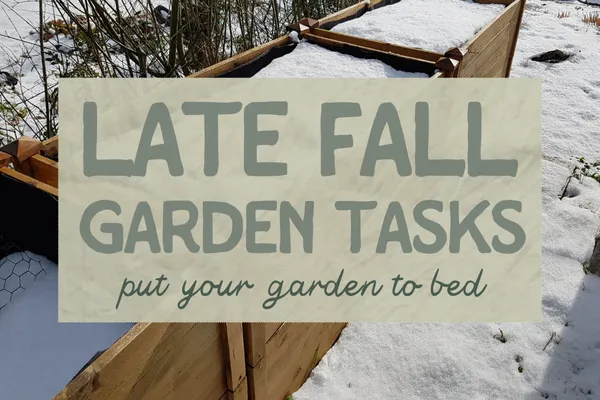
Get Your Garden Winter-Ready! 🌨️
Preparing Your Mountain Garden for Winter: A Step-by-Step Guide 🌨️
As the days get shorter and the temperatures dip, it’s time to tuck your garden in for its winter rest. Preparing your garden now will help ensure that your plants are protected and your soil stays healthy—so when spring rolls around, you’ll have a head start on a thriving garden!
Here’s a step-by-step guide to getting your garden winter-ready, with tips, tricks, and helpful reminders for gardeners in mountain climates.
Step 1: Assess Your Garden—Lessons from This Year 📋
Before you jump into winter prep, take a moment to reflect on the successes and challenges of the season. Grab a notebook and jot down:
- What worked well? What didn’t?
- Are there plants that need to be moved to a sunnier or more sheltered spot?
- Could you use more privacy or screening to block an eyesore?
- Do you need more plants with fall color or late-season blooms?
👉 Pro Tip: Keep this list handy when shopping for plants next spring. If you need help finding perennials to add, just come visit us!
Step 2: Remove Annuals and Store Pots 🌸
Once the first hard freezes hit, it’s time to say goodbye to your annuals. Although it can be tough to pull out those late bloomers, getting ahead of frost damage will make your life easier. Here’s what to do:
- Remove annuals from both garden beds and containers.
- Compost healthy plants and dispose of diseased plants.
- Store your pots indoors or in a sheltered area to prevent cracking.
💡 Not sure what to do with those "kinda fancy" pots that pre-made arrangements often come in? Bring your lightly used decorative pots to the shop. We'll happily save your pots from the landfill when building our pre-made pots. Or bring them into the shop next year, and we can help you fill them back up.
Step 3: Plant Spring Bulbs and Garlic 🌷
Get a jump on spring by planting bulbs now. Tulips, daffodils, crocuses, and many others are ready to go into the ground during fall.
- Use animal repellant or cover the bulbs with chicken wire if squirrels and chipmunks are a problem.
- Layer bulbs alongside your existing perennials. The bulbs provide early color and the later blooming shrubs and perennials hide the fading bulb foliage in late spring
🌟 Shop our selection of fall planted bulbs.
Step 4: To Cut or Not to Cut? ✂️
We try to leave as much of the garden intact over the winter as possible. Most insects have entered their winter state and benefit from the protection of your leaves and plant material! Learn more.
- Cut back: Diseased foliage that could harbor next year's pests.
- Do not cut back: Evergreen or woody-stemmed perennials, and those with winter interest like ornamental grasses and coneflowers. Delaying your garden clean up until spring benefits the ecosystem! Leave those leaves (and pretty much everything else if you can!)
🙋♀️ Need help identifying what to cut? We’re happy to advise!
Step 4: Gather Cut Branches and Dried Flowers for Indoor Use 🍂
Bring a bit of your garden’s beauty indoors by gathering dried flowers and branches to use in arrangements.
- Collect hydrangea flowers, berried branches, ornamental grasses, and seed pods for fall centerpieces or wreaths.
- Decorating with natural elements adds a seasonal touch to your home.
🌼 Join our winter wreaths and decor workshop to bring a bit of the garden indoors this winter!
Step 5: Continue to Water Until the Ground Freezes 💧
Even though your garden may look like it’s going to sleep and your irrigation has been shut off, your plants’ roots are still growing. Keep watering until the ground freezes, especially:
- Newly planted trees, shrubs, and perennials.
- Evergreen plants that need extra moisture.
🌲 Adding mulch can help keep the soil warm and prevent freeze-thaw damage. Ask us which type is right for your garden!
Step 6: Rake, Shred, and Mulch with Leaves 🍁
Nature gives us free mulch every fall—so let’s use it!
- Rake broad leaves like cottonwood and aspen, as they can smother plants if left on the ground.
- Shred the leaves and spread them as mulch over garden beds to insulate plants and suppress weeds.
🛒 Need extra mulch? We have plenty in the shop.
Step 7: Protect Sensitive Plants 🛡️
Some plants need extra protection to survive the winter. Here’s how to help them out:
- Cover sensitive plants with mulch or evergreen boughs once they’ve gone dormant.
- Mulch newly planted perennials to prevent the rootball from being pushed out by freeze-thaw cycles.
🌲 Come by the store to explore our range of mulches—perfect for insulating your garden!
Final Thoughts: It’s Never Too Early to Dream About Next Year’s Garden 🌸
Once your garden is prepped for winter, it’s time to start thinking about spring. What new plants will you try? Where will you add color or create privacy? There’s no better time to start dreaming than now!
Lindsay completes most of her edible landscaping designs over the winter for spring installation. Schedule a call with her today!
Need Supplies or Advice? We’re Here to Help! 🌻
At Wiggle Worm Gardens, we have everything you need to get your garden winter-ready. From perennials and bulbs to compost and mulch, we’ve got you covered. Stop by for personalized advice and check out our fall sales before the season ends! Check our social media for current hours!
Copyright 2023-2025 Wiggle Worm Gardens
Visit Our Sister companies
Fourth Street Farm: edible landscaping and raised bed garden design and installation
Ground Up: Soil health and compost tea

